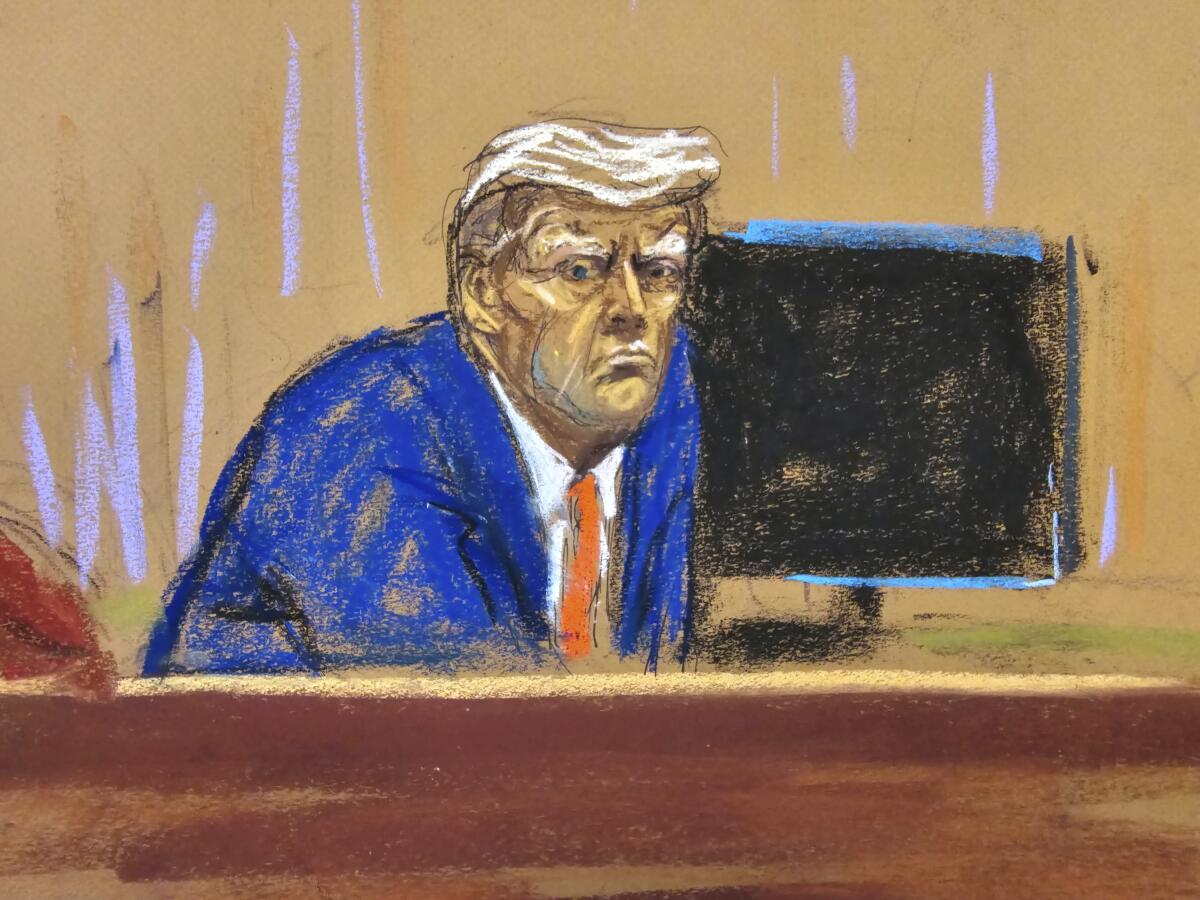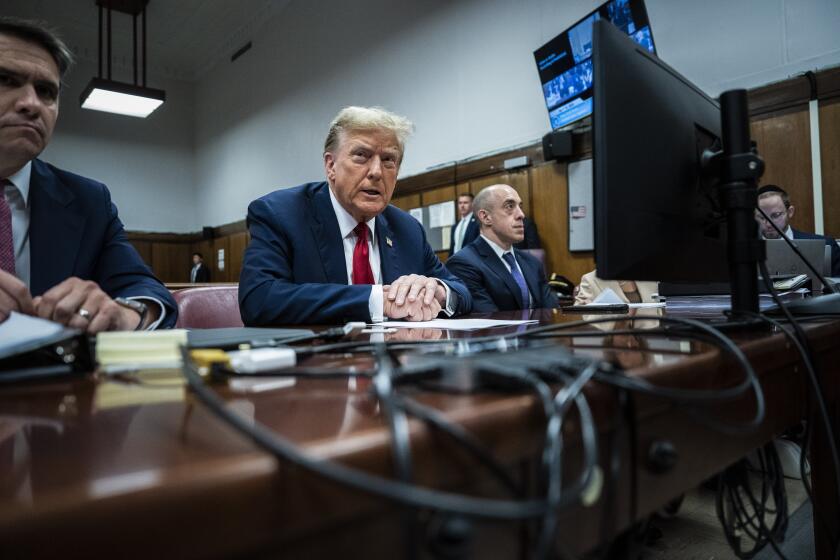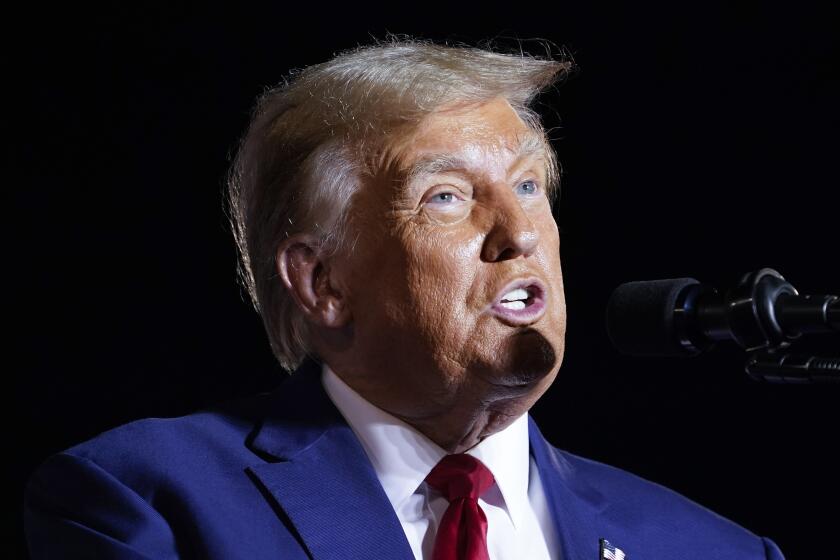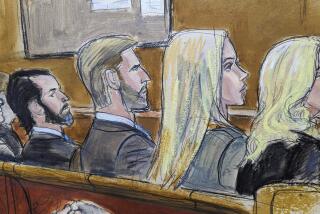Trump trial: Why can’t Americans see or hear what’s happening inside N.Y. courtroom?

- Share via
NEW YORK — It’s a moment in history — the first U.S. president facing criminal charges in an American courtroom. Yet only a handful of observers are able to see or even hear what is going on.
Instead, most of the nation is getting news of former President Trump’s hush money trial secondhand. Reporters in a Manhattan courtroom must convey what is being said to the outside world after the fact.
That’s all because New York state law regarding media coverage of court proceedings is one of the most restrictive in the country. The recent death of O.J. Simpson, whose murder trial was beamed live from a Los Angeles courtroom captivated a nation three decades ago, was a telling reminder of how New York is behind the times — or, at least, a holdout.
Trump faces the first of four criminal trials that will cut into his campaigning. He is accused of falsifying records to hide payments to a porn actor.
Why won’t New York let me see it?
Regulations limiting media coverage in courtrooms date back nearly a century, when the spectacle of bright flashbulbs and camera operators standing on witness tables during the 1935 trial of the man accused of kidnapping and killing Charles Lindbergh’s baby son horrified the legal community, according to a 2022 report by the New York-based Fund for Modern Courts.
Rules to enforce decorum spread nationally, amended to account for the invention of television, as defense lawyers worried that video coverage would harm their cases, the report said.
Yet an interest in open government chipped away at these laws and — slowly, carefully — video cameras began to be permitted in courts across the country, often at the discretion of judges presiding in individual cases.
New York allowed them too on an experimental basis between 1987 and 1997, but they were shut down. Lobbyists for defense lawyers remain strong in New York and hold particular sway among lawyers in the state Assembly, said Victor Kovner, a former New York City corporation counsel who advocates for open courtrooms.
Donald Trump is pushing for his federal election interference trial in Washington to be televised, joining media outlets in the request.
New York and Louisiana are the only states remaining that completely forbid video coverage, the Fund for Modern Courts said.
To Kovner and others, that’s outrageous.
“We’re the media capital of the world, we like to think, and the fact that cameras aren’t permitted in one of our three branches of government is unacceptable,” said New York state Sen. Brad Hoylman-Sigal, who has sponsored a bill to try to change that.
“It’s one of the most consequential trials of our modern age,” the senator said. “I think the public has a right to see exactly what happens in that courtroom.”
At the trial’s outset, some reporters suggested that it appeared there were times that Trump drifted off to sleep while watching the proceedings. The former president’s campaign disputed that. With no video camera in place and trained on him, there’s no way of knowing for sure.
Wait, I saw a photo of Trump in court at the trial’s start
That’s because the presiding judge, Juan M. Merchan, permitted a handful of still photographers to take pictures of Trump before the day’s proceedings. Once court was called into session, courtroom sketch artists — a dying communications form — hold sway.
There is actually some video coverage of the trial, available on monitors in an overflow room adjacent to the main courtroom. It has been packed with reporters, court officers and a few members of the public, including Ron Sinibaldi, a former accountant from Long Island who lined up outside the courthouse before midnight for a seat on April 15.
“I read presidential biographies,” Sinibaldi said. “I go to presidential libraries. I’m here for the history.”
How are those involved compensating for the restrictions?
In a hallway outside the courtroom, a limited number of cameras and a small pool of reporters are positioned to capture remarks of anyone involved in the trial who wants to address the outside world. That included Trump, even before the proceedings started.
Absent live coverage of the trial, how often the former president chooses to take advantage of those cameras and whether news organizations carry his remarks — either live, taped or not at all — will play a big role in how the case is perceived publicly.
MSNBC carried his remarks live on the first day of jury selection. “They’re trying to grab the narrative regardless of the outcome,” CNN reporter Phil Mattingly said of the Trump defense team.
How are journalists handling the restrictions?
With some difficulty. CNN stationed a team on the streets of Manhattan outside the courtroom, where a truck festooned with pro-Trump flags frequently drove by, blaring horns and music from loudspeakers. Reporters sometimes struggled to be heard. “It is kind of a circus down here,” CNN’s Kaitlan Collins said.
Commentators and experts, many of them with experience in jury selection, offered opinions from outside the courtroom or from studios. Fox News analyst Jonathan Turley said that “most cities, at least those outside of New York,” will see the case as a weaponization of criminal justice.
It’s the first criminal trial of any former U.S. commander-in-chief and the first of Trump’s four indictments to reach trial.
Will other Trump cases be televised?
Georgia, where Trump faces charges of election meddling, gives judges discretion over whether to allow television cameras. Fulton County Superior Court Judge Scott McAfee has said he will make all hearings and trials in the case against Trump there available for broadcast. That has already included hearings on whether Fulton County Dist. Atty. Fani Willis would be removed from the case.
Federal courts do not allow cameras in criminal cases. Trump is facing separate federal cases for alleged election interference and mishandling of classified documents, although it is not clear when, or if, those trials will take place.
The federal cases offer one glimmer of hope: The U.S. Supreme Court permits audio of oral arguments to be broadcast outside the courtroom. But there’s no indication that this would apply to Trump’s case. New York’s law does not allow audio coverage of his hush money trial.
Proponents of legislation to open up New York courts to electronic media coverage are hoping the attention paid to the Trump case may boost their proposals. The idea is being considered as part of current negotiations over the New York state budget, so, theoretically, a new law could even affect the Trump trial if it is passed and goes into effect immediately.
Given New York’s history, it’s best not to count on it.
Bauder writes for the Associated Press. AP writers Jennifer Peltz and Jake Offenhartz in New York and Anthony Izaguirre and Maysoon Khan in Albany, N.Y., contributed to this report.
More to Read
Sign up for Essential California
The most important California stories and recommendations in your inbox every morning.
You may occasionally receive promotional content from the Los Angeles Times.















